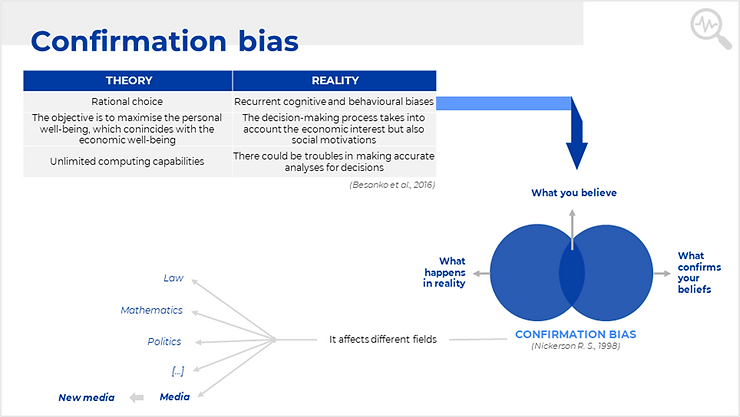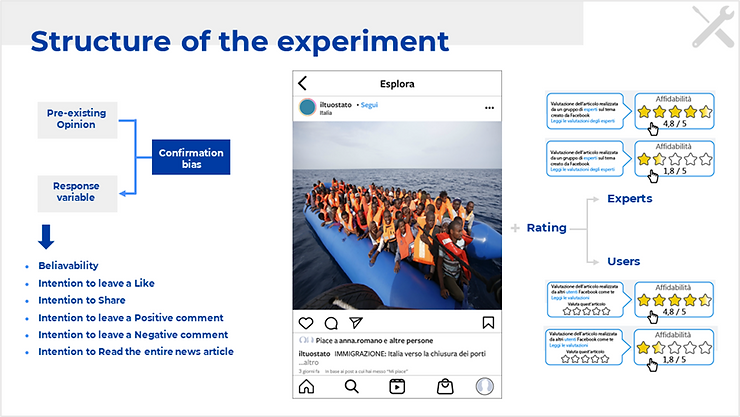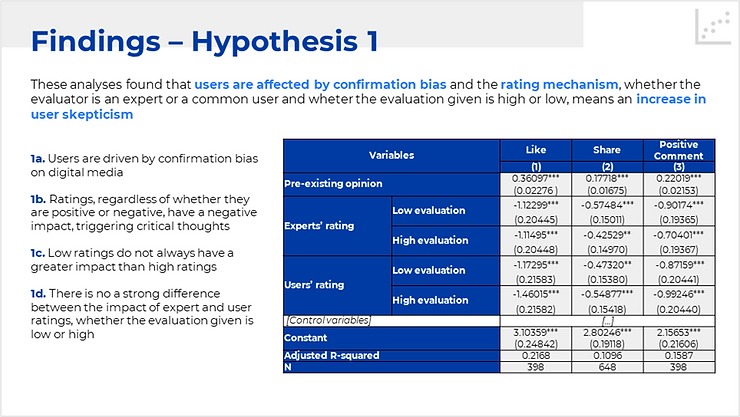
How important is a belief? The impact of confirmation bias on online fake news’ engagement
Nowadays, spreading fake news and conspiracy theories are a very hot topic. Although these have always represented an issue, they have only been put in the spotlight in the latest years, due to today’s way of getting information and the characteristics of new media. It was during the 2016 United States presidential election that the term “fake news” was first used, in its current meaning, at a national level.
According to behavioral economics, people are not as classical economic theory describes. For example, instead of making choices rationally, there are recurrent cognitive and behavioral distortions, called biases, that influence them. Among these, there is the confirmation bias, which consists in the major propensity of people to pay attention to information that confirms their a priori opinion. They are more likely to believe and to share them, without having any concern about their actual reliability. On the other hand, they are more likely to be suspicious of facts that support different points of view. This bias is right at the heart of the fake news phenomenon.

Roberta Cameriere’s study analyses the phenomenon of fake news in the online environment, which is the one most affected by this issue in Italy. The digital platforms that are analyzed are two social media, Facebook and Instagram, and a search engine, Google. In this research, it has been examined the presence of confirmation bias and the potential effect generated by a rating mechanism. In detail, two types of rating mechanisms are considered: on one hand, there is an expert on the subject, who evaluates the quality of the article that spreads the news, and, on the other hand, there is an ordinary user of the platform. Moreover, three scenarios are examined: an “As is” scenario, in which there isn’t a rating mechanism, and two potential “To be” scenarios, one with a high rating and the other with a low rating. The idea behind the research is that if the news that is shared online were flanked by an evaluation of the quality of the article itself, this would encourage the user to reflect more on such information and, consequently, reduce the spreading of fake news.
In order to carry out the analysis, it was built a quantitative questionnaire, through which it was possible to collect data from 648 respondents of the general population. Around 90 linear regression models were selected to answer the main research questions. Furthermore, the two types of visual stimuli reported below were included in the experiment.


One represents the “As is” scenario, that is the current situation on the platforms that are analyzed, while the other is a “To be” scenario, that is the current situation plus a box containing an explanation of the rating mechanism and the rating that is given, which is either high or low, by a certain kind of evaluator. Only one type of rating is shown to each user, so they will only see rating mechanisms in which the evaluator is the expert or in which the evaluator is the user. Through the analysis of these two independent, homogeneous and representative samples of the Italian population, it was possible to answer the main research questions.

Among the most important results of the research, it was found that:
-
Confirmation bias, which is at the basis of the fake news phenomenon, represents a problem in Italy, on the three analyzed platforms, because the impact of the pre-existing opinion predictor on the response variables, that are the believability and engagement of the news, is always positive and significant;
-
The rating mechanism, regardless of the type of evaluator and the evaluation given, could represent a valuable option to fight fake news’ spreading, as it pushes the users to be more critical towards the news presented to them, in fact, the impact of the presence of the rating mechanism, compared to its missing, is always negative and significant;
-
Given that the confirmation bias was analyzed in relation to different topics, it was concluded that its impact differs based on the topic covered by the news, since there are topics that are more affected by confirmation bias and, vice versa, topics that are less affected;
-
Although it has been said that the type of rating mechanism does not matter, as it turns out to be useful anyway, through further analysis it was observed that when the evaluators are ordinary users, they are impacted by confirmation bias in their judgment, so this mechanism should not be preferred;
-
An attempt to combine the advantages of the two mechanisms (expert/common user evaluator) was made, testing a third solution in which the ordinary user who rates is in turn rated by other users, in order to mitigate the disadvantages arising from the lack of objectivity characteristic of this kind of evaluator, taking inspiration from the “Top Reviewers” systems, commonly used in e-commerce websites; however, this proposal did not turn out to be sufficiently effective, since it appeared that even users who rate users, evaluators of the quality of the articles, are impacted by confirmation bias.

Among the conclusions of these analyses, there is that those who deal with online information and/or the platforms investigated should take this issue into account. They should pay more attention to the news covering the topics that are most impacted. In a more realistic context than the ones analyzed in previous research, where news circulating cover different areas, only some of them seem to be affected by confirmation bias. Therefore, it is better to focus more on these kinds of news. To do that, it might be a good solution to use a rating mechanism, preferably where the evaluator is an expert on the subject.


